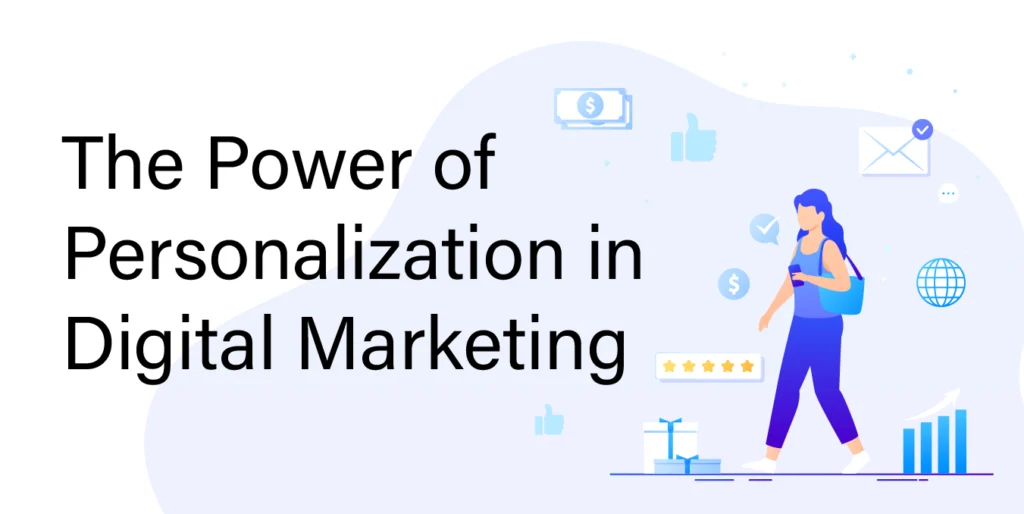Table of Contents
Let’s be honest—nobody likes being treated like just another name on a list. In fact, in today’s world, where ads follow you around like overexcited puppies and inboxes are drowning in offers, one thing stands out above all else: personalization in marketing.
We’re not just talking about emails that say, “Hi [Your Name]!”
That’s the bare minimum.
Real personalization means knowing what your audience needs, what they care about, and showing up for them in the moments that matter. It’s about saying, “Hey, we actually see you”—and meaning it.
So, if your marketing still feels like you’re shouting into the void, this one’s for you.
What Exactly Is Personalization in Marketing?
In simple words, personalization in marketing is about creating content, messages, or experiences that feel like they were made just for someone specific—not for “everyone.”
You’ve seen it in action:
- Netflix recommends shows based on what you’ve watched
- Amazon suggests products that actually make sense for you
- Spotify creates those scarily accurate “Made For You” playlists
That’s not magic. That’s smart marketing built around you.
Whether it’s an email, a product recommendation, or a social ad, personalization in marketing makes people feel like you understand them—and that connection is what drives real results.
Why Everyone’s Talking About Personalization (And Why You Should Too)
Let’s cut to the chase: personalization works. Like, really works.
Here’s what the numbers say (because we’re all curious):
- 80% of people say they’re more likely to buy from a brand that offers personalized experiences
- Personalized emails can lead to 6x more sales
- Almost everyone—91% to be exact—prefers brands that remember their likes and habits
Think about it from your own perspective: When a brand “gets you,” doesn’t it just feel easier to buy from them?
That’s the magic of personalization in marketing. It builds trust, makes things easier, and feels way more human.
What Personalization Really Looks Like in 2025
So what does personalization in marketing look like in action? Here’s how brands are doing it (and how you can too):
1. Personalized Emails That Don’t Feel Robotic
We’ve all gotten those emails that start with “Dear valued customer…” Yikes.
Instead, send messages that speak to the person’s real interests. Recommend items based on what they browsed. Follow up after purchases with tips or how-tos. Birthday discounts? Yes, please.
2. Websites That Feel Like They Were Made for You
Imagine going to a site and seeing content, products, or offers based on your behavior, not just a generic homepage.
That’s personalization in marketing doing its job. You feel seen—and more likely to stick around.
3. Social Ads That Don’t Feel Like Ads
Ever get an Instagram ad for something you literally just needed? That’s personalization. Creepy? Sometimes. Effective? Always.
4. E-commerce That Knows You Like a Friend
Your favorite online store probably already personalizes your shopping journey—showing you similar items, reminding you of what you forgot in your cart, or recommending items that go with what you already bought.
How to Start Personalizing (Without Overthinking It)
Feeling overwhelmed? Don’t be. You don’t need a huge team or a tech wizard to make personalization in marketing work for you. Here’s how to ease in:
Step 1: Get to Know Your Audience
Use tools like Google Analytics, surveys, or even social media polls. What are people clicking on? What are they ignoring? The more you understand, the better you can tailor your messaging.
Step 2: Segment Like a Human, Not a Spreadsheet
Group your audience based on interests, behavior, or even purchase history. It’s not about over-complicating—it’s about speaking directly to what people care about.
Step 3: Automate Where It Makes Sense
Platforms like Mailchimp, Klaviyo, or HubSpot let you send the right message at the right time, without doing it manually each time.
Step 4: Don’t Just Guess—Test
Try different subject lines. See if personalized product recommendations work better. Small tests can show you what’s clicking with your audience (literally).
Personalization Isn’t Perfect—And That’s Okay
Look, personalization in marketing isn’t about getting it 100% right every time. It’s about trying to connect in more thoughtful ways. And yes, there are some traps to avoid:
- Don’t overdo it. If you start every message with someone’s name, it’ll feel forced.
- Don’t be creepy. Mentioning something too specific (like their recent location or private info) can make people uncomfortable.
- Keep it real. Use personalization to be helpful, not pushy.
- Stay ethical. Respect privacy laws like GDPR or CCPA. Let people control how their data is used.
When in doubt, ask: Would I appreciate this if I were the customer?
Some Brands Doing It Right
A few brands are absolutely nailing personalization in marketing, and you can learn from them.
- Spotify: Their “Wrapped” campaign is basically free, viral advertising driven by personal data.
- Sephora: They use your shopping history to suggest what’s next—and even remember your skin tone preferences.
- Netflix: No two homepages look the same. That’s because their entire model is built around personal viewing habits.
- Coca-Cola: Even putting people’s names on bottles (“Share a Coke”) felt personal—and it worked.
What’s Next? The Future of Personalization in Marketing
Technology’s evolving fast, and so is personalization.
We’re talking:
- AI-powered product suggestions
- Personalized video messages
- Voice assistants that know your habits
- Websites that change in real time based on your mood, behavior, or even location
But remember: the tools might get smarter, but the goal stays the same—making marketing feel more human.
Final Thoughts: It’s Not About Data—It’s About People
At the end of the day, personalization in marketing isn’t just a tactic. It’s a shift in mindset.
It’s choosing to talk with your audience, not at them.
It’s recognizing that behind every click, every scroll, every “add to cart,” there’s a real person.
So here’s your challenge: Stop trying to reach everyone. Start building real connections with someone—and do it well.
Because when you take the time to personalize your marketing, you’re not just growing your business.
You’re building trust. Loyalty. And long-term success.

